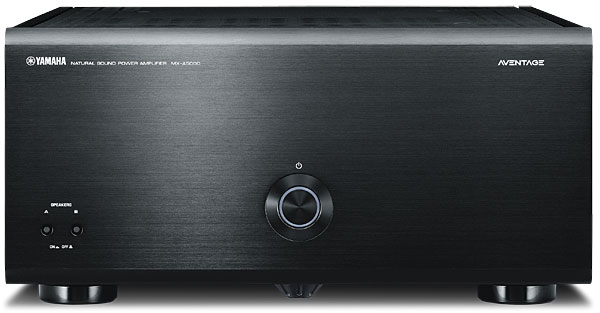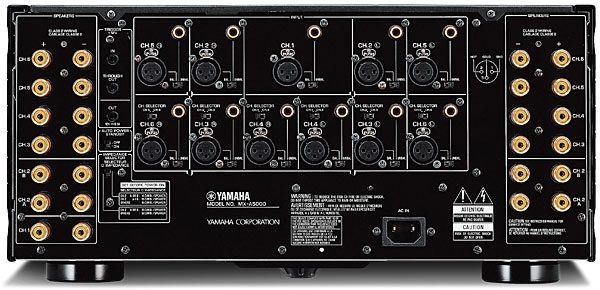Yamaha CX-A5000 Surround Processor and MX-A5000 Amplifier Page 2
That New-Car Smell
Setting up the pre/pro is fairly simple if you’re familiar with Yamaha’s tabbed setup menus. But if you’re a novice, you may have to take a trip into the manual. While you can access the pre/pro through your home network via the aforementioned apps or directly through its IP address from a computer on your network, you can’t use them to set up the unit for the first time. Those more modern setup methods are something I’ve found handy on other units I’ve reviewed, and I’d love to see Yamaha implement them in future products. One other tiny pet peeve: You must have your display on to enter the setup menu. None of the options is available on the text-based display on the front of the unit—not a lot of fun for those of us who have to power up a front projector just to tweak a setting while listening to two-channel music.

I used two different amplifier setups in my evaluation: my reference Parasound A 51 and A 23 combination in a traditional 7.1 configuration (to see how well the controller mated with amps that I know really well) and Yamaha’s matching 11-channel MX-A5000. The spec sheet states the Yamaha will deliver 150 watts per channel with two channels driven, but like with a lot of products, it doesn’t state what the amp will do with all channels driven. Still, my experience causes me to doubt the amp will deliver anything close to the specified power with even seven channels driven (see the Test Bench for its true power capability). Even though mass has no direct relationship to power output, it’s sometimes an indication of the heft of the power supply. At 56 pounds, the MX-A5000 is a lightweight compared with my 80-pound A 51, which has only five channels.
Despite its somewhat pedestrian specs and weight, the MX-A5000 has an overall build quality matching that of the CX-A5000, and it offers a number of customizable options. With 11 channels to play around with, you could run a conventional five- or seven-channel setup in your main listening room and use the extra amps to power a couple of two-channel zones elsewhere in your home. Or you can biamp up to five channels of speakers in your main listening room if your speakers offer that capability. Or you can go big and power all 11 speakers in one room with the addition of the two front and two rear height speakers. So whereas having all of your amps in one box means you may give up a little power per channel, it also means you get more convenience.
Cool Kid on the Block
I used the CX-A5000 for nearly a month, and the first thing that struck me—besides the great sound—was how cool the pre/pro was after extended use. In fact, it never got over 100 degrees, which is something I can’t say about my reference Marantz AV8801 pre/pro. As you probably know, overheating of electronics is never a good thing for their longevity, which is why I installed custom fans in my rack to keep all my gear under the century mark.
Friends is one of the best sitcoms in the history of television, and my wife and I have been revisiting the series on Blu-ray with our teenage kids for almost a year now. While the Yamaha was in the rack, we were on season 8. Customarily, a sitcom isn’t demo-worthy material, but in the episode “The One Where Joey Tells Rachel,” there’s a great scene in a restaurant where Joey professes his newfound love for his friend. What struck me was the amazing ambience the Yamaha exhibited with the sounds of silverware clanking on plates, ice water pouring into glasses, and patrons chattering. It really gave me that “being there” feeling. Both sets of amplifiers excelled in this and other types of environmental effects, not only in sitcoms but also in feature-length films and live sporting events.

Star Trek Into Darkness is the second film from J.J. Abrams in the rebooted Star Trek universe, and its Dolby TrueHD 7.1 soundtrack on Blu-ray is demo-worthy for virtually the entire movie. The action scenes are filled with directional effects flying through the room, and while the bass response isn’t the deepest I’ve heard, it’s by no measure a slouch. Comparing the Yamaha amp with my Parasounds showed some distinct differences between the two solutions. The Parasounds certainly had a lot more power in the action scenes, with clearer detail in the directional effects and a more robust midrange for Michael Giacchino’s wonderful score. Granted, I wasn’t able to switch between the two setups on the fly, and it required a few minutes to rewire things, but I’m confident the Parasound combo was the superior choice and packed a lot more punch, as it should—the A 51 alone costs $4,500 and is rated at 250 watts per channel, all channels driven, versus the Yamaha’s 150 watts x 2 rating and $3,000 price tag. So it was no surprise that Yamaha’s amp couldn’t keep pace with the more powerful Parasounds. It wasn’t bad, but it couldn’t quite give the CX-A5000 its full due.
And that was a lot: The audio quality from Yamaha’s surround processor is a surefire winner. Whether it was two-channel stereo, streamed FLAC files from my home server, or multichannel tracks from Blu-ray concert discs, I was never left wanting for my Marantz reference pre/pro. While I really liked the audio output from the CX-A5000 with its sibling amp, I loved the combination with the Parasound amps. Imaging with two-channel stereo created a phantom center presence; you’d swear that all three front channels were engaged if you were sitting in the money spot on my couch. But the true testament to how well the pre/pro dealt with music came when I popped in the Blu-ray of Roy Orbison: Black and White Night. Intending to sample a few tracks, I ended up watching the entire disc because I was so mesmerized by the crystal-clear midrange and room-filling bass response. I toggled between the YPAO settings (Flat, Front, Natural, and Through, the last of which disables the equalizer) and preferred the Flat response because it moved the vocals more forward and gave them a tad more presence, especially compared with the Through setting (which didn’t sound remotely bad, just different and more laid-back).
It’s Hard to Say Goodbye
Living with the Yamaha CX-A5000 has been a pleasure; I hope my Marantz won’t feel like a jilted lover when it finally goes back in the rack. It’s an outstanding value, given its bevy of features and terrific audio performance, and it definitely deserves its Top Pick status. On the other hand, the MX-A5000 amplifier, while certainly scoring points for its convenient form factor and 11-channel offering, was merely competent; I found its power output a bit wanting. But that’s the beauty of living in the world of separates: You can pick and choose your parts in order to achieve the best results for your equipment. In fact, if I hadn’t just plunked down some hard-earned cash on the Marantz earlier this year, I’d have a hard time letting the CX-A5000 leave my home. Yes, folks, it’s that impressive.




























































